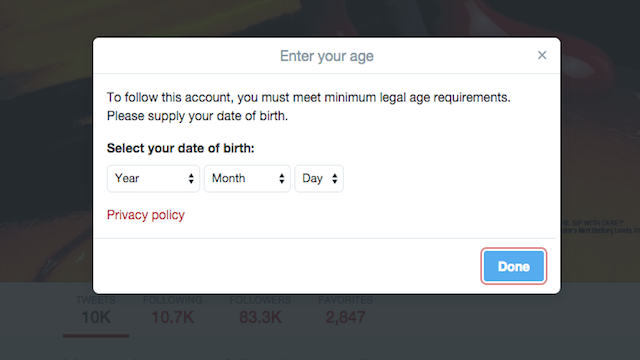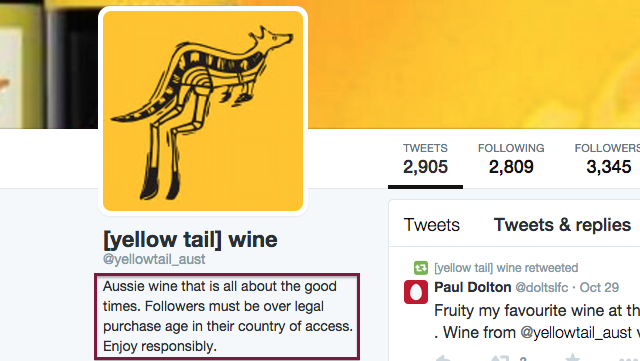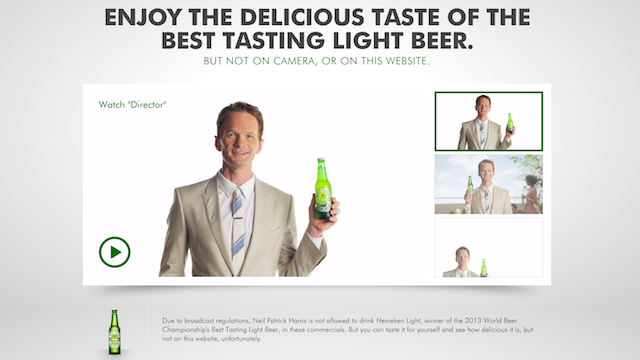Please Link Responsibly: Social Media Guidelines for Alcohol Marketing
Written by Jennifer Beese
Published on March 30, 2015
Reading time 10 minutes

Known for game day-stealing marketing campaigns and clever cross-platform advertising, alcohol brands are key content creators on social media. But while these brands appear to have no trouble giving people something to talk about, they face tough regulatory challenges when it comes to alcohol social marketing and engagement.
The Alcohol Industry and Self-Regulation
According to the Federal Trade Commission, the three major alcohol supplier trade associations—the Beer Institute, Distilled Spirits Council of the United States (DISCUS) and Wine Institute—have adopted voluntary advertising and marketing codes. The codes, which are periodically reviewed by the FTC, include guidelines designed to reduce the likelihood that alcohol advertising will target consumers below the legal drinking age. Depending on your industry, you’ll want to become very familiar with the following codes:
- Beer Institute Advertising and Marketing Code
- DISCUS Code of Responsible Practices
- Wine Institute Code of Advertising Standards
The basic principles addressed in each of the above codes are as follows:
- Digital marketing communications are intended for adults of legal purchase age.
- Digital marketing communications should be placed only in media where at least 71.6 percent of the audiences is of the legal purchase age.
- Digital marketing communication that involves direct interaction with a user should require age affirmation prior to engagement.
- User-generated content on a site or page controlled by the brand must be monitored and moderated on a regular basis.
- Digital marketing communications that are intended to be forwarded by users should include instructions that the content shouldn’t be forwarded to individuals below the legal purchase age.
- Digital marketing communications must respect user privacy.
For better understanding, we take a closer look at each of these rules below. Bear in mind that most of the discussion outlined in this article comes from a US perspective, and the rules and regulations around alcohol promotion vary by country.

Demographics and Age Restrictions
Knowing your audience is the first step to successful communication. In 2014, 67 percent of Americans aged 12 and older said they use social media. Thus, alcohol brands are highly restricted in this area.
While the average business can choose to market anywhere across the social media landscape, alcohol marketers in the US are restricted to platforms where 71.6 percent of the audience is over 21 years of age. This not only limits the platforms alcohol brands can use to reach customers, but it also forces them to diligently research each platform before creating a profile.
Platform-Specific Demographics
According to the Pew Internet Project’s 2012 research on teens, 95 percent of 12–17 year olds were online, with 81 percent using some kind of social media. Of those, 77 percent used Facebook, and 24 percent used Twitter.
There isn’t a wealth of demographic data around teens specifically, but more recent research shows that Instagram has become very popular among the younger generation. According to eMarketer, 11.4 million of Instagram’s 300 million members are 17 or younger.
As of spring 2014, 30 percent of 12–17 year olds favor Instagram, while 27 percent and 23 percent prefer Twitter and Facebook, respectively.
Age Affirmation
One thing to be aware of in your research is how “adult” is defined. For example, Nielsen reported that 71 percent of online adults use Facebook, as of January 2014. However, Nielsen considered anyone over the age of 18 to be an adult, which isn’t much help for alcohol brands in the US. Fortunately, other data from Nielsen has shown that more than 80 percent of audiences on Facebook, Twitter and YouTube are older than 21.
Ensuring a 21-plus audience only gives you the right to be on the platform and post updates; it doesn’t permit you to follow people or reply to their comments. This makes for a very one-sided conversation and creates a major barrier for brands looking to engage with current and prospective customers. The only way around this restriction is through age affirmation, which both Facebook and Twitter have.
Twitter, for instance, has an age-screening feature that requires people to provide their date of birth in order to follow an alcohol brand. It’s triggered when a user clicks “Follow” on an alcohol brand’s profile and requires a date of birth to be entered. Twitter will check that the age entered matches the legal drinking age for the country associated with the person’s account.
Once successfully verified, the person’s follower status will be confirmed, and Twitter will remember that the account met the age requirement so that the person won’t need to go through the age verification process again. If someone’s entry doesn’t meet the legal drinking age in his or her country, that person’s follow request will be denied.
Facebook restricts visitation of alcohol brand Pages, allowing access only to Americans who have previously registered as being 21 or older. Alcohol ads also are displayed only to people who are 21 or older, and underage users are unable to view friends’ Likes of alcohol-related Pages.
YouTube offers brands the option to require either date of birth entry or to limit alcohol channel visitation to registered US users who are 21 or older.
Instagram recently passed the 71.6 percent threshold—previously, its user base was too young—but it doesn’t yet provide people with a way of verifying their age. This restricts any two-way conversation between brands and customers. Still, even though brands cannot follow anyone back or reply to anyone’s comments, many followers still show their loyalty by liking and commenting on the brands’ posts. Most brands place some sort of disclaimer in their bios, such as this one from Guinness (note how it points followers to Facebook, where guidelines allow for a more open dialogue):
Choose Platforms Wisely
Regardless of restrictions (and work-arounds), not all platforms make sense for every brand. It’s wise to start with a sound social strategy before launching any new channels. For instance, if your target audience is primarily male, you might have less of an impact on Pinterest, where females dominate the demographic. If two-way dialogue is an important component of your strategy, then being active on Instagram won’t be the best use of your time either. The same with other social networks—if the demographics don’t match up, there’s no sense in trying to force it.
mike’s hard lemonade is especially diligent on this front. The brand has experienced much success on Facebook and Twitter, thanks in part to age-gating, but its latest product offering, Palm Breeze, will be entering unchartered waters with the company’s first-ever Instagram ad campaign.
“We’re always on the lookout for the new and upcoming social channels to see what they could do for our brand,” said Diane Sayler, Senior Marketing Manager of Content at mike’s hard lemonade. “It’s important for us to focus on channels that work best with our target consumer for each product in our portfolio.”
Keep in mind that the legal drinking age is different depending on which country you’re in. If you have an international audience, it might be worth creating separate accounts for each country for more accurate targeting.
“It’s important for us to focus on channels that work best with our target consumer for each product in our portfolio.”
—Diane Sayler, Senior Marketing Manager of Content at mike’s hard lemonade
Social Monitoring
Most marketers are keen on the importance of social listening. It not only makes your engagement more efficient and effective, but it also give you a sense of the general sentiment around your brand, product or competitors. For alcohol brands, however, social listening isn’t just a nice-to-have; it’s a must.
In fact, the self-regulatory guidelines state that alcohol brands must police user-generated content that is inappropriate or that promotes irresponsible or underaged drinking. Brands are advised to monitor user-generated content each business day or, at minimum, every five business days.
Be sure to remove inappropriate content promptly. Since you can’t remove a Tweet that you didn’t post, this applies mostly to your blog, Facebook Timeline and Instagram comments. Follow these instructions to remove inappropriate comments from your Instagram photos.
On Facebook, you can minimize the amount of questionable content appearing on your Timeline by adjusting Posting Ability in Settings.
Check the second box, and you’ll be able to review every post made by someone other than a Page Admin before anything is displayed on your Timeline. This will make it easier to focus on incoming comments and replies.
According to an FTC study, one company reported rejecting about 8 percent of all user-generated content, largely because the posts contained profanity, encouraged excessive consumption or involved unauthorized advertising or spam.
Regardless of how you choose to regulate your channels, it’s a good idea to add a clear disclaimer for all your fans to see, stating that any inappropriate content will be removed. It’s also important that you stick to removing inappropriate content, as defined by the guidelines, and don’t make a habit out of removing your own posts or updates.
User Privacy
Privacy policies exist to govern the collection of personal information from fans and followers. Usually, they’re hard to find or full of legalese that nobody reads. According to DISCUS guidelines, alcohol brands’ privacy policies must ensure the following:
- Prior to the collection of any information, the brand will require an individual to affirm that he or she is of legal purchase age, and user information can only be collected from those individuals who are of the legal purchase age.
- The brand shall employ a mechanism for a person to opt in before receiving a direct digital marketing communication and opt out to discontinue receiving direct communications.
- Clear information must be provided about collection and use of personal data. Under no circumstances will the information collected be sold or shared with third parties unrelated to the brand.
- People should be encouraged to read the privacy statement before submitting their information.
- Measures will be taken to keep user information secure and protected from loss or theft.
Bacardi sets a great example of transparency. The brand has a clear and easy to read privacy policy and prominently links to it in the About Section of its Facebook Page.
Platform-Specific Challenges
In addition to the restrictions above, be mindful of a few limitations within each platform. Twitter, for example, limits the bio text field to 160 characters. Many alcohol brands include some sort of “drink responsibly” statement there, leaving little room to say more.
Although regulations don’t require that these statements appear in a particular location, it’s strongly recommended that they’re placed where a viewer “would most logically expect to find information about the brand or the company.” Since this is generally the bio section (often governed by character limits), alcohol brands on Twitter and Instagram are at a slight disadvantage.
Marketing Success Stories
Despite the limitations placed on advertising, alcohol brands have still enjoyed great success on social. Here are a few companies that are making a splash responsibly.
mike’s hard lemonade
Staying closely aligned with Beer Institute guidelines, mike’s recently switched to a full digital marketing strategy. As a result, it hit one million fans on Facebook this past summer, making it the largest flavored malt beverage on social at the time. To celebrate its 1 millionth fan, Paul Siano, mike’s became paul’s hard lemonade for 24 hours.
“Even with restrictions in the way that we advertise, social media is a great asset for our company because it gives us the opportunity to connect with our fans in a transparent, fun and interactive way,” says Sayler. “Creativity is cultivated through challenges, and here at mike’s, our team is quick, innovative and steps up to the challenge.”
Heineken
While there isn’t a law preventing people from drinking beer on camera, the Beer Institute’s voluntary guidelines state that beer advertising “should not depict situations where beer is being consumed rapidly, excessively, involuntarily, as part of a drinking game, or as a result of a dare.” That said, several broadcast networks adhere to the outdated Television Code that prohibited showing alcohol being consumed.
So how can you effectively market your product if you can’t show someone using it? Heineken took a humorous, yet straightforward approach:
In this video series, the brand teamed up with actor Neil Patrick Harris to bring its “Best Tasting Light Beer” award to life. Harris pines over wanting to take a sip, but due to regulations in the US, is prevented from tasting the product on camera.
https://www.youtube.com/watch?v=bK2uqjgOxDA
The tongue-in-cheek, three-video series has more than 7.8 million views on YouTube.
Budweiser
Rather than use humor, Budweiser went the emotional route. The brand has become a fan favorite due in part to its 2014 Super Bowl commercial, “Puppy Love,” which featured a heartwarming tale of a puppy and one of the iconic Clydesdale horses. The video has received more than 57.7 million views—more than any other Super Bowl spot that year.
Building on that success, Budweiser brought back a puppy for its 2014 PSA against drunk driving and for its 2015 Super Bowl “Lost Dog” ad. The latter has roughly 28 million views, while the former, released in September 2014, lapped up more than 22.5 million views and trended with the hashtag #friendsarewaiting.
Even though these commercials might not inspire people to go buy a beer, they build awareness for the brand in a socially responsible way.
Whitehall Lane
Contests and giveaways are popular marketing tactics for brands looking to attract new fans and reward loyal customers. Unfortunately, companies regulated by the federal Alcohol and Tobacco Tax and Trade Bureau are prohibited from running contests that use booze as a prize.
Whitehall Lane Winery, however, doesn’t let TTB guidelines stop it from growing a community of loyal fans online. With a strong social presence, the winery partners with complementary brands to give away wine glasses and cookbooks as a way to reward fans.

The company also celebrates fans by reposting user-generated content on Instagram, Facebook and Twitter. Each re-post includes a shout-out to the original poster. It’s a great way to acknowledge fans, but it also helps visually promote your product without running the risk of violating any rules.
https://instagram.com/p/yGRGo1GUsg/
The family-owned winery has 1,100 followers on Instagram, 4,954 Likes on Facebook and 5,555 followers on Twitter.
Going Global
As stated, the rules and regulations identified in this article apply mostly to the US. If you’re marketing to a global audience, before you launch your campaign, familiarize yourself with each country’s restrictions. Canada, for instance, has rules against even giving the impression, visually or in sound, that alcohol is being consumed. In Finland, alcohol-branded social media has been banned entirely. Make sure you adapt your social media campaigns accordingly.
- Categories
How to effectively run a multi-location review management strategy
Published on October 22, 2020 Reading time 7 minutes - Categories
The complete guide to social media for restaurants & bars
Published on January 27, 2020 Reading time 7 minutes









Share